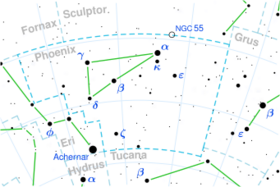Astronomy:Kappa Phoenicis
| Observation data Equinox J2000.0]] (ICRS) | |
|---|---|
| Constellation | Phoenix |
| Right ascension | 00h 26m 12.20183s[1] |
| Declination | −43° 40′ 47.3929″[1] |
| Apparent magnitude (V) | 3.94[2] |
| Characteristics | |
| Spectral type | A5IVn[3] |
| U−B color index | +0.11[2] |
| B−V color index | +0.17[2] |
| Astrometry | |
| Radial velocity (Rv) | +11.30[4] km/s |
| Proper motion (μ) | RA: +106.20[1] mas/yr Dec.: +32.15[1] mas/yr |
| Parallax (π) | 42.00 ± 0.15[1] mas |
| Distance | 77.7 ± 0.3 ly (23.81 ± 0.09 pc) |
| Absolute magnitude (MV) | 2.05[3] |
| Details | |
| Mass | 1.74[5] M☉ |
| Radius | 2.03+0.10 −0.19[6] R☉ |
| Luminosity | 10.7±0.1[6] L☉ |
| Surface gravity (log g) | 4.30[5] cgs |
| Temperature | 7,320+369 −176[6] K |
| Metallicity [Fe/H] | -0.04[3] dex |
| Rotational velocity (v sin i) | 245.0[7] km/s |
| Age | 348[5] Myr |
| Other designations | |
| Database references | |
| SIMBAD | data |
| ARICNS | data |
κ Phoenicis, Latinized as Kappa Phoenicis, is a single[9] star in the southern constellation of Phoenix. It is visible to the naked eye as a white-hued point of light with an apparent visual magnitude of 3.94.[2] The distance to this star is approximately 77.7 light years based on parallax,[1] and it is drifting further away with a radial velocity of +11 km/s.[4] It is a member of the Castor Moving Group of co-moving stars.[10]
This object has a stellar classification of A5IVn,[3] which matches the spectrum of an A-type subgiant star with "nebulous" lines due to rapid rotation. It is 348[5] million years old and is spinning with a projected rotational velocity of 245 km/s.[7] The star has 1.7[5] times the mass of the Sun and 2.0[6] times the Sun's radius. It is radiating 10.7[6] times the luminosity of the Sun from its photosphere at an effective temperature of 7,320 K.[6] The star displays an infrared excess that matches the signature of a debris disk orbiting 9 astronomical unit|AU from the host star with a temperature of 170 K.[11]
References
- ↑ 1.0 1.1 1.2 1.3 1.4 1.5 Van Leeuwen, F. (2007). "Validation of the new Hipparcos reduction". Astronomy and Astrophysics 474 (2): 653–664. doi:10.1051/0004-6361:20078357. Bibcode: 2007A&A...474..653V. Vizier catalog entry
- ↑ 2.0 2.1 2.2 2.3 Ducati, J. R. (2002). "VizieR On-Line Data Catalog: Catalogue of Stellar Photometry in Johnson's 11-color system". CDS/ADC Collection of Electronic Catalogues 2237. Bibcode: 2002yCat.2237....0D.
- ↑ 3.0 3.1 3.2 3.3 Anderson, E.; Francis, Ch. (2012). "XHIP: An extended hipparcos compilation". Astronomy Letters 38 (5): 331. doi:10.1134/S1063773712050015. Bibcode: 2012AstL...38..331A. Vizier catalog entry
- ↑ 4.0 4.1 Evans, D. S. (1967). "The Revision of the General Catalogue of Radial Velocities". Determination of Radial Velocities and Their Applications 30: 57. Bibcode: 1967IAUS...30...57E.
- ↑ 5.0 5.1 5.2 5.3 5.4 David, Trevor J.; Hillenbrand, Lynne A. (2015). "The Ages of Early-Type Stars: Strömgren Photometric Methods Calibrated, Validated, Tested, and Applied to Hosts and Prospective Hosts of Directly Imaged Exoplanets". The Astrophysical Journal 804 (2): 146. doi:10.1088/0004-637X/804/2/146. Bibcode: 2015ApJ...804..146D. Vizier catalog entry
- ↑ 6.0 6.1 6.2 6.3 6.4 6.5 Brown, A. G. A. (August 2018). "Gaia Data Release 2: Summary of the contents and survey properties". Astronomy & Astrophysics 616: A1. doi:10.1051/0004-6361/201833051. Bibcode: 2018A&A...616A...1G. Gaia DR2 record for this source at VizieR.
- ↑ 7.0 7.1 Glebocki, R.; Gnacinski, P. (2005). "Catalog of Stellar Rotational Velocities". VizieR On-Line Data Catalog: III/244. Originally Published in: 2005csss...13..571G 3244. Bibcode: 2005yCat.3244....0G. Vizier catalog entry
- ↑ "kap Phe". SIMBAD. Centre de données astronomiques de Strasbourg. http://simbad.u-strasbg.fr/simbad/sim-basic?Ident=kap+Phe.
- ↑ Eggleton, P. P.; Tokovinin, A. A. (September 2008). "A catalogue of multiplicity among bright stellar systems". Monthly Notices of the Royal Astronomical Society 389 (2): 869–879. doi:10.1111/j.1365-2966.2008.13596.x. Bibcode: 2008MNRAS.389..869E.
- ↑ Vereshchagin, S. V.; Chupina, N. V. (2015). "Details of the spatial structure and kinematics of the Castor and Ursa Major streams". Baltic Astronomy 24 (4): 421–425. doi:10.1515/astro-2017-0244. Bibcode: 2015BaltA..24..421V.
- ↑ Cotten, Tara H.; Song, Inseok (July 2016). "A Comprehensive Census of Nearby Infrared Excess Stars". The Astrophysical Journal Supplement Series 225 (1): 24. doi:10.3847/0067-0049/225/1/15. 15. Bibcode: 2016ApJS..225...15C.
 |


